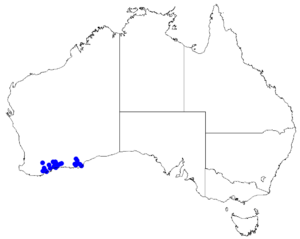Boronia inconspicua facts for kids
Quick facts for kids Boronia inconspicua |
|
|---|---|
| Conservation status | |
| Scientific classification | |
 |
|
| Occurrence data from Australasian Virtual Herbarium |
The Boronia inconspicua is a special kind of plant. It belongs to the Rutaceae family, which is also known as the citrus family. This means it's related to oranges, lemons, and other citrus fruits!
This plant is endemic to the south-west part of Western Australia. This means it naturally grows only in that specific area and nowhere else in the world. It's a type of shrub that has leaves shaped like feathers, called pinnate leaves. Its flowers are small and can be white or a creamy green color. Each flower has four petals and eight stamens, which are the parts that make pollen. You can find this plant growing from the Stirling Range all the way to Mount Ragged.
Contents
What Does Boronia inconspicua Look Like?
The Boronia inconspicua is a shrub that can grow in different shapes. It might stand up straight, spread out, or grow into a round, compact bush. It can reach a height of about 1 m (3 ft), which is about 3 feet tall. Its branches can be smooth without hairs, or they might have a few soft hairs.
Its Unique Leaves
The leaves of this plant are pinnate. This means they are made up of smaller leaflets arranged like a feather. Each leaf can have three, five, or seven of these small leaflets. They are usually tough and leathery, and they are narrow, from 3 mm (0.1 in) to 10 mm (0.4 in) long.
Its Tiny Flowers
The flowers of Boronia inconspicua are quite small. They can grow alone or in small groups called cymes. Each flower sits on a smooth stalk called a pedicel, which is about 2 mm (0.08 in) to 4 mm (0.2 in) long.
The flower has four small, triangular, and leathery sepals. These are like tiny leaves that protect the flower bud, and they are only about 0.6 mm (0.024 in) long. The four petals are white to creamy green and are about 1.5 mm (0.059 in) long. They have tiny bumps on them called glands. Inside the flower, there are eight stamens that have a few hairs. The stigma, which is the part that receives pollen, is very small. This plant usually blooms from September to December.
How Was This Plant Named?
The Boronia inconspicua was first officially described in 1863. A famous botanist named George Bentham gave it its scientific name. He studied a plant sample collected by another botanist, James Drummond. The description was then published in a book called Flora Australiensis.
The second part of its scientific name, inconspicua, comes from a Latin word. It means "not easily seen" or "not standing out". This name probably refers to its small, subtle flowers.
Where Does Boronia inconspicua Grow?
This type of boronia plant usually likes to grow on rocky areas. You can find it in the Esperance Plains and Mallee areas of Western Australia. These areas are part of special biogeographic regions, which are places with similar plants, animals, and environments. Its range stretches from the Stirling Range to Mount Ragged.
Is This Plant Protected?
Good news! The Boronia inconspicua is currently classified as "not threatened" by the Western Australian Government's Department of Parks and Wildlife. This means it is not in danger of disappearing.


